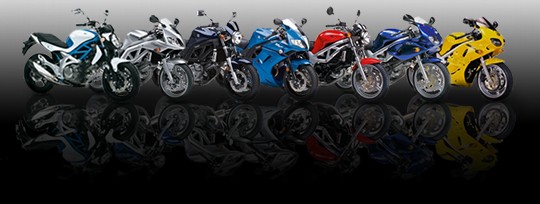 |
 |
| Bikes - Talk & Issues Newsworthy and topical general biking and bike related issues. No crapola! Need Help: Try Searching before posting |
 |
|
|
Thread Tools |
|
|
#1 |
|
Guest
Posts: n/a
|
Good day,
Now I know that for accelerating a A/F of around 13.5:1 is best. What im wondering though is, what A/F is an engine tuned for when it comes to cruising, so steady throttle just to maintain speed, ill guess its not the same as acceleration... but what is it? Also what about deceleration, obviously there should be a lot less fuel, so what is a good A/F for that? Cheers for any info!!!! |

|
|
|
#2 |
|
Member
Mega Poster
Join Date: Jul 2003
Location: Warwickshire
Posts: 2,804
|
"Stoichiometric" A/F is typically about 14.7:1 (by mass), I say typically because it depends on the exact make-up of the fuel. The ratio is termed "lambda", so lambda=1 is stoichiometric, higher than 1 means more air (lean).
Older spec engines (carbs or very early FI) might run slightly lean at mid-loads, say up to about 16:1. There are 2 basic limiting factors to this, one is the lean-limit of the combustion chamber (mixture at which combustion does not initiate reliably, usually described as a statistical variation in IMEP or 0-10% mass fraction burned or a similar measure), the second is that transitions have to be carefully managed, trying to add extra load suddenly from a lean condition will often cause misfires/hiccups, requiring acceleration enrichment either by accel pumps or careful carb slide damping or similar. FI systems usually have an accel function calibrated into them using either throttle angle or mass flow measurements. Many modern engines meeting current or recent emission regs will run "closed loop" over most of the part load range, where the lambda sensor monitors exhaust gas. It's a bit like a battery, it compares oxygen in the exhaust and in the atmosphere, if there is no oxygen in the exhaust (but there is in the air) it gives a voltage output and the ECU leans the mixture off (progressively, ramp rates depend on various things) until there is free oxygen in the exhaust and the output suddenly drops to near zero, then the ECU switches over to progressively leaning the mixture off. It all gets a lot more complicated with things like direct injection gasoline engines where charge isn't homogeneous and it can run with lean overall mixtures but locally rich near the plug (what was usually referred to a "stratified charge" once upon a time). This makes emission control rather complicated but can offer significant benefits in fuel efficiency. The fundamental reason for most engines running stoichiometric is to allow "3-way" catalysts to work effectively, so called because they deal with oxidation of hydrocarbons, carbon monoxide, and also reduction of oxides of nitrogen all at the same time. They will only do this when the overall ratio of oxygen to H, C, and N is very close to ideal. Lean mixtures in the cylinder will tend to lower HC and CO "raw" emissions but increase NOx, and the opposite with rich mixtures. It's very difficult to get the oxygen off NOx when there is free oxygen in the exhaust gas. You can try a search of things like "regulated pollutants" or "exhaust emission control" or similar for more detailed info. Most FI engines will have an "overrun fuel cut-off" function, so no fuel is injected. The slightly tricky bit is "re-instatement". To make it refined the ignition is usually retarded considerably while the fuel switches back on when load is applied again, and the ignition ramps back up to the map value over a few engine cycles, this softens the effect. In car engines re-instatement usually occurs on overrun at around 1500rpm (slowing down) in order to maintain driveability and prevent stalling if you dip the clutch when it's in fuel cut-off.
__________________
"Artificial Intelligence is no match for natural stupidity" Last edited by embee; 29-07-10 at 02:21 PM. |
|
|

|
|
|
#3 |
|
Noisy Git
Mega Poster
Join Date: Apr 2007
Location: Halifax/Leeds
Posts: 26,645
|
Whhhhhy
__________________
Currently Ex Biker
Now rebuilding a 63' fishing trawler as a dive boat |
|
|

|
|
|
#4 |
|
Guest
Posts: n/a
|
Cheers embee, some interesting reading.
Chris, its cos I wonder, some people have a little more fuel in when throttle closed to reduce engine braking. Another reason is I'm still having that slight issue with constant throttle with constant throttle being a tiny bit jerky. I'm wondering if it could be that the tps is reading a little on the side of thinking the throttle is more open than it is and maybe its running rich... could cause this jerk? Don't suppose you know anything about all that? I know I've asked a fair amount in different ways but I'm trying to sort this... I'm wondering if putting it on a dyno would show, but then that's why I wondered what a good a/f for constant throttle would be. Last edited by ThEGr33k; 29-07-10 at 04:57 PM. |

|
|
|
#5 |
|
Guest
Posts: n/a
|
Take it to Paul at Dynobike in Malton. Pay him £140 and have your bike transformed. He'll give you all the info you'll ever need on Af ratios.
(and he'll set your bike up to run at 12.5:1 to 13:1) C Last edited by Berlin; 29-07-10 at 06:25 PM. |

|
|
|
#6 | |
|
Noisy Git
Mega Poster
Join Date: Apr 2007
Location: Halifax/Leeds
Posts: 26,645
|
Quote:
More fuel will increase irreversibility in engine, as you put energy into fuels latent heat of vaporisation and do not get it back. Thus increasing engine braking. Fuel is added on overrun to smooth transition, it will be jerky otherwise. Surging about is usually a lean issue. TPS could cause it, set it a tad earlier and see what happens. Dyno would not show it unless you put it on a dynapro eddy current one and test it under steady state condition. Dynojet inertia type would not show you problem unless you also have a lean issue at WOT.
__________________
Currently Ex Biker
Now rebuilding a 63' fishing trawler as a dive boat |
|
|
|

|
|
|
#7 |
|
Guest
Posts: n/a
|
Surely you can run at constant throttle on both types, its similar maybe minus a little wind blast to just doing it on the road surely? Couldnt hold it at the same RPM while the engine is trying to accelerate.
Im reasonably certain it isnt caused by a lean problem as I find that adjusting the CO pots richer just makes the throttle horribly slow to react, and going leaner makes it run nicer, crisper. Suppose the only thing to do is get it sniffed... The bike runs fine accelerating slowing down, except at same place where the cruising surge is (2200-3000RPM which is where I ride in town), Wack throttle open at any RPM and it picks up pretty well. Oh and any Eddy Current dyno's around here? Last edited by ThEGr33k; 29-07-10 at 11:39 PM. |

|
|
|
#8 |
|
Guest
Posts: n/a
|
Go to Malton, Tell Paul the above and he'll fix it for you. He's a very clever man.
He'll also explain everything to you in as much detail as you can handle (Im assuming you have a PC fitted of course) C |

|
|
|
#9 |
|
Noisy Git
Mega Poster
Join Date: Apr 2007
Location: Halifax/Leeds
Posts: 26,645
|
no, the clue is in the name of an INERTIAL dyno you spoon!
__________________
Currently Ex Biker
Now rebuilding a 63' fishing trawler as a dive boat |
|
|

|
|
|
#10 |
|
Guest
Posts: n/a
|
|

|
 |
|
|
 Similar Threads
Similar Threads
|
||||
| Thread | Thread Starter | Forum | Replies | Last Post |
| Q/A throttle | Davies 52 | Stuff Wanted | 5 | 28-07-10 03:31 PM |
| Motorcycle riding positions explained | Brettus | Idle Banter | 15 | 07-02-10 11:12 PM |
| Lever positions - Thanks! | MavUK | SV Talk, Tuning & Tweaking | 3 | 04-06-08 06:49 PM |
| Replacement fuel light / fuel tap | riktherider | SV Talk, Tuning & Tweaking | 7 | 14-05-07 06:41 PM |
| gear ratio's | Warren | Bikes - Talk & Issues | 5 | 14-10-04 10:29 PM |